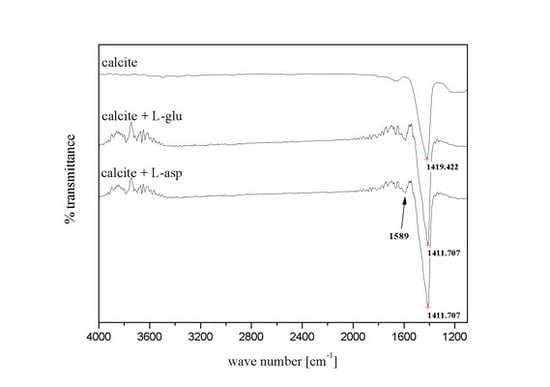Comparison of Dissolution and Surface Reactions Between Calcite and Aragonite in L-Glutamic and L-Aspartic Acid Solutions
Abstract
:1. Introduction
2. Results and Discussion
2.1. Dissolution equilibrium of calcite in 0.02 M acetic acid solution
2.2. Dissolution behavior of calcite in amino acid solutions
2.3. ATR-FTIR analysis of calcite surface
2.4. Insoluble aragonite in amino acid solutions
2.5. Surface morphology change due to the dissolution
3. Experimental
3.1. Raw materials
3.2. Experimental set-up
4. Conclusions
Acknowledgements
References and Notes
- Blesa, M.A.; Morando, P.J.; Regazzon, A.E. Chemical Dissolution of Metal Oxides, 1st ed.; CRC Press Inc.: Boca Raton, FL, USA, 1994; pp. 3–7. [Google Scholar]
- Liang, Y.; Bear, D.R.; Mccoy, J.M.; Amonette, J.E.; Lafemina, J.P. Dissolution kinetics at the calcite-water interface. Geochim. Cosmochim. Acta 1996, 60, 4883–4887. [Google Scholar] [CrossRef]
- Demadis, K.D.; Mavredaki, E.; Stathoulopoulou, A.; Neofotistou, E.; Mantzaridis, C. Industrial water systems: problems, challenges and solutions for the process industries. Desalination 2007, 213, 38–46. [Google Scholar] [CrossRef]
- Teir, S.; Eloneva, S.; Fogelholm, C.J.; Zevenhoven, R. Stability of calcium carbonate and magnesium carbonate in rainwater and nitric acid solutions. Energy Consers. Manage. 2006, 47, 3059–3068. [Google Scholar] [CrossRef]
- Cubillas, P.; Köhler, S.; Prieto, M.; Chaïrat, C.; Oelkers, E.H. Experimental determination of the dissolution rates of calcite, aragonite, and bivalves. Chem. Geol. 2005, 216, 59–77. [Google Scholar] [CrossRef]
- Chada, V.G.R.; Hausner, D.B.; Strongin, D.R.; Rouff, A.A.; Reeder, R.J. Divalent Cd and Pb uptake on calcite {10-14} cleavage faces: An XPS and AFM study. J. Colloid. Interface. Sci. 2005, 288, 350–360. [Google Scholar] [CrossRef] [PubMed]
- Hoffman, U.; Stipp, S.L.S. The behavior of Ni2+ on calcite surface. Geochim. Cosmochim. Acta 2001, 65, 4131–4139. [Google Scholar] [CrossRef]
- Sánchez, A.G.; Ayuso, E.Á. Sorption of Zn, Cd and Cr on calcite. Application to purification of industrial wastewaters. Miner. Eng. 2002, 15, 539–547. [Google Scholar] [CrossRef]
- Fredd, C.N.; Fogler, H.S. The kinetics of calcite dissolution in acetic acid solutions. J. Colloid Interface Sci. 1998, 204, 187–197. [Google Scholar] [CrossRef] [PubMed]
- Plummer, L.N.; Wigley, T.M.L.; Parkhurst, D.L. The kinetics of calcite dissolution in CO2-water systems at 5o to 60 oC and 0.0 to 1.0 atm CO2. Am. J. Sci. 1978, 278, 179–216. [Google Scholar] [CrossRef]
- Wang, T.; Li, Z. Dissolution kinetics of granular calcium carbonate in concentrated aqueous sodium dichromate solution at pH 6.0-7.0 and 110-130 °C. J. Colloid Interface Sci. 2001, 281, 130–135. [Google Scholar] [CrossRef] [PubMed]
- Wilkins, S.J.R.; Compton, G.; Viles, H.A. The effect of surface pretreatment with polymaleic acid, phosphoric acid, or oxalic acid on the dissolution kinetics of calcium carbonate in aqueous acid. J. Colloid Interface Sci. 2001, 242, 378–385. [Google Scholar] [CrossRef]
- Lee, S.W.; Kim, Y.I.; Ahn, J.W. The use of iminodiacetic acid for low-temperature synthesis of aragonite crystal microrods: Correlation between aragonite crystal microrods and stereochemical effects. Int. J. Miner. Process. 2009, 92, 190–195. [Google Scholar] [CrossRef]
- Gutjahr, A.; Dabringhaus, H.; Lacmann, R. Studies of the growth and dissolution kinetics of the CaCO3 polymorphs calcite and aragonite I. Growth and dissolution rates in water. J. Cryst. Growth. 1996, 158, 296–309. [Google Scholar] [CrossRef]
- Demjén, Z.; Pukánszky, B.; Földes, E.; Nagy, J. Interaction of silane coupling agents with CaCO3. J. Colloid Interface Sci. 1997, 190, 427–436. [Google Scholar] [CrossRef]
- Pavia, D.L.; Lampman, G.M.; Kriz, G.S. Introduction to spectroscopy, 2nd ed.; Saunders College Publishing: Orlando, FL, USA, 1996; pp. 29–80. [Google Scholar]
- Lu, Y.; Miller, J.D. Carboxyl stretching vibrations of spontaneously adsorbed and LB-transferred calcium carboxyates as determined by FTIR internal reflection spectroscopy. J. Colloid Interface Sci. 2002, 256, 41–52. [Google Scholar] [CrossRef]
- Kellar, J.J.; Young, C.A.; Knutson, K.; Miller, J.D. Thermotropic phase transition of adsorbed oleate species at a fluorite surface by in situ FT-IR/IRS spectroscopy. J. Colloid Interface Sci. 1991, 144, 381–389. [Google Scholar] [CrossRef]
- Sung, C. Perspectives in Transmission Electron Microscopy; Bando Publishing Co.: Seoul, Korea, 1992; pp. 68–86. [Google Scholar]
- Ahn, J.W.; Park, C.H.; Kim, J.H.; Lee, J.K.; Kim, H. Synthesis of ultrafine calcium carbonate powders from high concentrated calcium hydroxide solution. J. Korean Assoc. Cryst. Growth 1996, 6, 509–520. [Google Scholar]
Sample Availability: Not available. |










| 0.002 M | 0.005 M | 0.01 M | 0.02 M | |
|---|---|---|---|---|
| Calcite + acetic acid | - | - | - | 360 mg/L (0.01 M) |
| Calcite + L-asp | 13 mg/L (0.0003 M) | 24 mg/L (0.0006 M) | 60 mg/L (0.0015 M) | 102 mg/L (0.0025 M) |
| Calcite + L-glu | 16 mg/L (0.0004 M) | 31 mg/L (0.0008 M) | 65 mg/L (0.0016 M) | 124 mg/L (0.0031 M) |
| Aragonite + each of the solutions | Under 10 mg/L | |||
© 2010 by the authors; licensee Molecular Diversity Preservation International, Basel, Switzerland. This article is an open-access article distributed under the terms and conditions of the Creative Commons Attribution license (http://creativecommons.org/licenses/by/3.0/).
Share and Cite
Ryu, M.; Kim, H.; Lim, M.; You, K.; Ahn, J. Comparison of Dissolution and Surface Reactions Between Calcite and Aragonite in L-Glutamic and L-Aspartic Acid Solutions. Molecules 2010, 15, 258-269. https://doi.org/10.3390/molecules15010258
Ryu M, Kim H, Lim M, You K, Ahn J. Comparison of Dissolution and Surface Reactions Between Calcite and Aragonite in L-Glutamic and L-Aspartic Acid Solutions. Molecules. 2010; 15(1):258-269. https://doi.org/10.3390/molecules15010258
Chicago/Turabian StyleRyu, Miyoung, Hwan Kim, Mihee Lim, Kwangsuk You, and Jiwhan Ahn. 2010. "Comparison of Dissolution and Surface Reactions Between Calcite and Aragonite in L-Glutamic and L-Aspartic Acid Solutions" Molecules 15, no. 1: 258-269. https://doi.org/10.3390/molecules15010258





